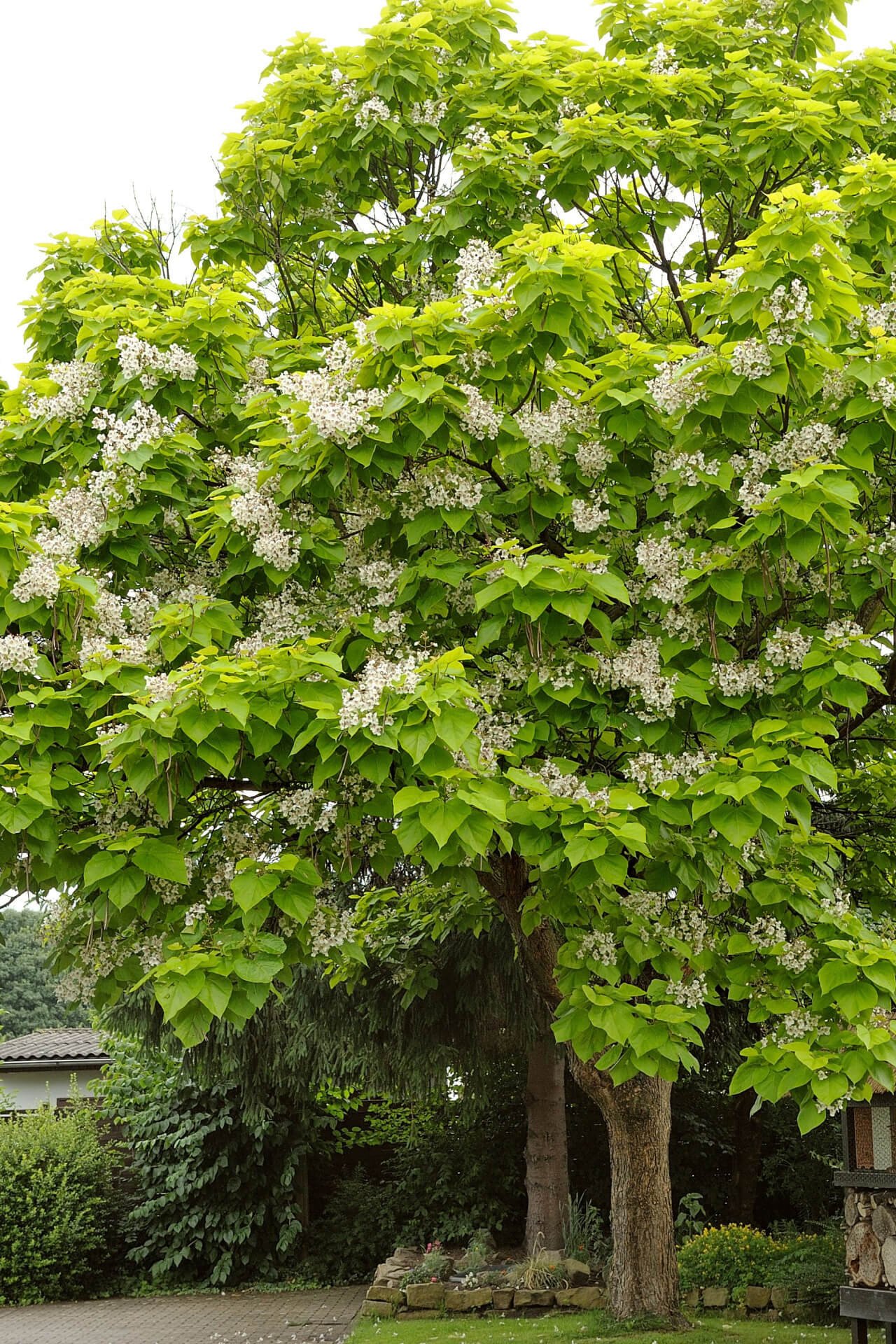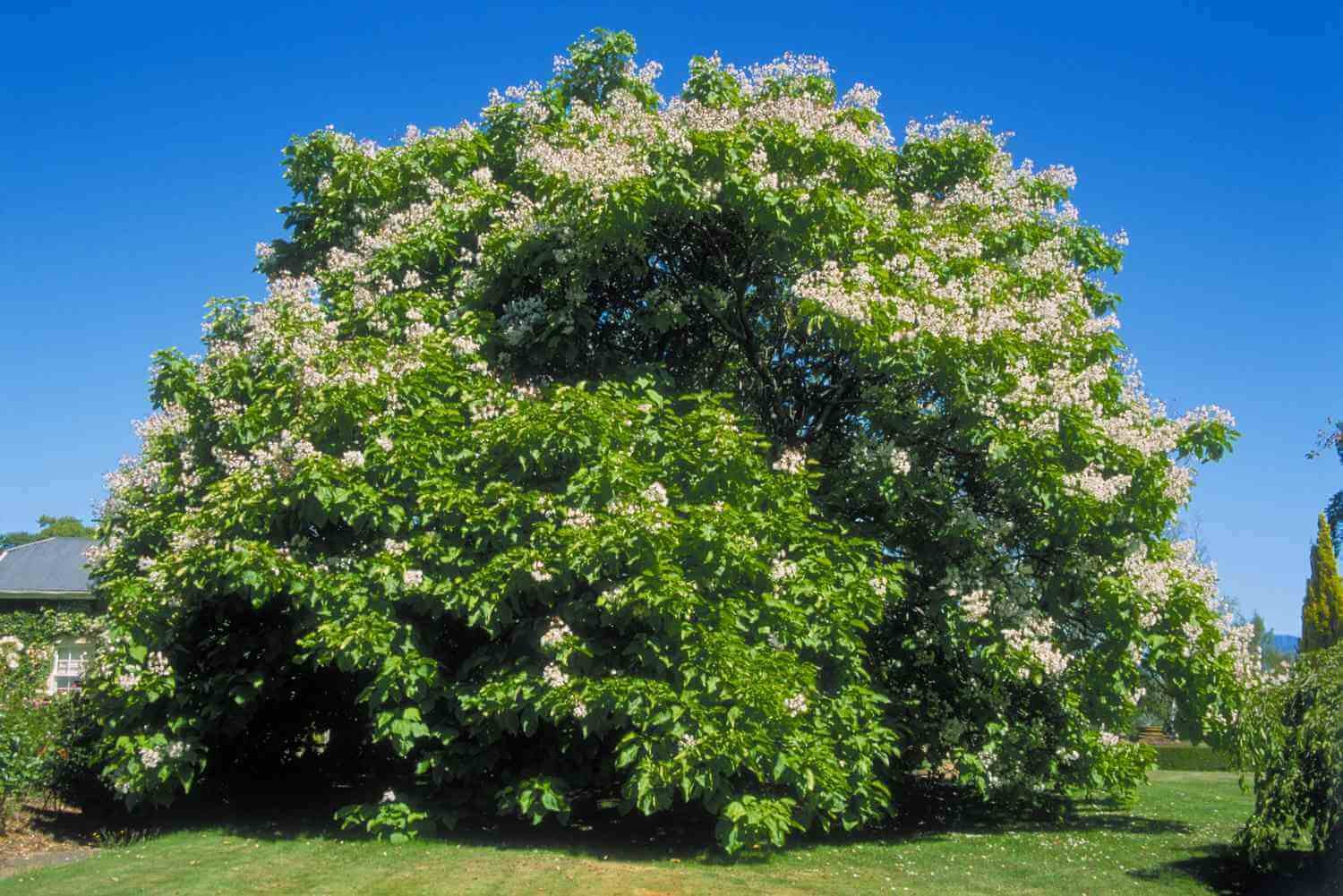



Catalpa Tree
Provides excellent shade coverage
Stunning large, fragrant flowers
Durable and resilient in diverse conditions
Thrives in
ZONE 7ZONE 8ZONE 9This plant ships:
7-10 Days1 Year Guarantee on all plants
Catalpa Tree - Catalpa speciosa Warder x Engelm
The Catalpa Tree (Catalpa speciosa Warder x Engelm) is a hardy and deciduous tree that is truly magnificent when at full maturity. It has beautiful white showy flowers.
Plant Details - Catalpa Tree
Family: Bignoniaceae
Light Requirement: Full Sun
Water Needs: Moist
Height: 40 – 70 ft.
Spread: 20 – 50 ft.
Growth Rate: Slow
Bloom Time: Spring
Flower Color: White
Wildlife Value: Attracts bees, birds
Landscape Uses and Maintenance - Catalpa Tree
The Catalpa Tree will create high drama in your yard or garden with its tall, statuesque branching habit, large light green and heart shaped leaves, and its showy flowers.
Plant this tree to create a shade garden, as a street tree on the outskirts of your property, or when making an allée you want to make a large impact.
Its large and showy flowers bloom in the spring. These flowers are white, wavy around the edges, and have accents of purple and orange. The flowers will give way to long, slender green seedpods that resemble green beans in nature, which turn brown as they mature.
Its bark is ridged with thick, chunky scales.
This is a low maintenance tree that will create dramatic impact on your property, making it a great option for the busy gardener.
Plant in a location with full sun to partial sun. Avoid planting it in the shade.
This tree prefers moist to wet soil, so be sure to keep it watered or plant in a moist location. Water thoroughly and deeply when it is first planted until it has become well established.
This is a deer resistant tree. Protect it when young and vulnerable to damage from deer and rabbit browsing.
As this tree ages, be sure to watch it for any damaged, diseased or decaying branches that may need to be removed to ensure the optimal health of the tree.
Noteworthy Characteristics
The Catalpa Tree is the host plant for the Catalpa Sphinx butterfly and is a host plant for other butterflies.
This Is How Your Plants Will Look upon Delivery

Bloom Season
Summer
Bloom/Foliage Color
White
Height at Maturity
Over 25 Feet
Care
Catalpa trees thrive in well-drained soil and require regular watering, particularly during dry spells. It's best to prune them in late winter to remove dead branches and maintain their shape. Keep an eye out for pests such as caterpillars, and provide enough space for their large, spreading canopy.
Plant Reproduction
The Catalpa tree spreads by wind-dispersed seeds from long pods.
Plant bare root trees during the dormant season in early spring or late fall (November through April). Dig the hole twice as wide as the roots so the soil is well-drained. Position the tree so the root flare is at or just above ground level. Fill the hole back with the soil you dug from and water. Maintain soil moisture, especially in the tree's early years, by providing deep, regular watering. Apply a 2-4 inch mulch away from the trunk at the base to retain moisture and suppress weeds. Prune trees during the first few seasons to establish strength and resilience, remove damaged branches, and continue maintenance pruning as the tree matures. Regularly inspect for pests and diseases and apply integrated pest management practices. Protect young trees from mechanical damage and extreme temperatures with tree guards, and stake them if necessary for support, removing the stakes after one or two years.
Shipping date depends on the date displayed and chosen when you order from the product's page.
We only accept returns on plants verified dead. If you think your plants have died, we offer a 1 year warranty, please use this File a Claim Link to verify dead plants and start with return warranty process.





.png?v=1722081809841&em-origin=cdn.accentuate.io&em-format=auto)
Fast Growth:
Catalpa Trees are known for their rapid growth, quickly reaching impressive heights. This makes them an ideal choice for those looking to establish shade or privacy in a short time, transforming landscapes swiftly.
Unique Seed Pods:
The long, distinctive seed pods of the Catalpa Tree add an interesting visual element to your garden. They also make great natural decorations for crafts and arrangements, adding a creative touch to home decor.
Wildlife Attraction:
These trees attract a variety of wildlife, including birds and pollinators, enhancing the biodiversity of your garden. The flowers and foliage provide food and shelter for beneficial creatures, supporting a healthy ecosystem.
Beautiful Blooms:
Catalpa Trees produce stunning white flowers in the spring, creating a visually captivating display. These blossoms add a touch of elegance and charm to any landscape, and their fragrance is an added delight.
Caring Tips
How do I care for my Catalpa Tree?
Each box contains detailed care instructions and information about your product. But here's the basics.
Care Tips
Catalpa trees thrive in well-drained soil and require regular watering, particularly during dry spells. It's best to prune them in late winter to remove dead branches and maintain their shape. Keep an eye out for pests such as caterpillars, and provide enough space for their large, spreading canopy.
Light Requirements
Catalpa trees thrive in complete sun to partial shade and require at least 6 hours of direct sunlight daily. But can tolerate some light shade, particularly in hot climates. Ensure they receive ample sunlight for optimal growth and flowering.
Hardy Planting Zones
7 • 8 • 9
Header
Use this content to share information about your store and products.
Frequently Asked Questions
How often should I water my plants?
How do I know if my plant is getting too much or too little sunlight?
What should I do to prepare my plants for winter?
What are the signs that my plant needs fertilizing?
How can I prevent pests from damaging my plants?
How do I choose the right plant for my climate zone?







